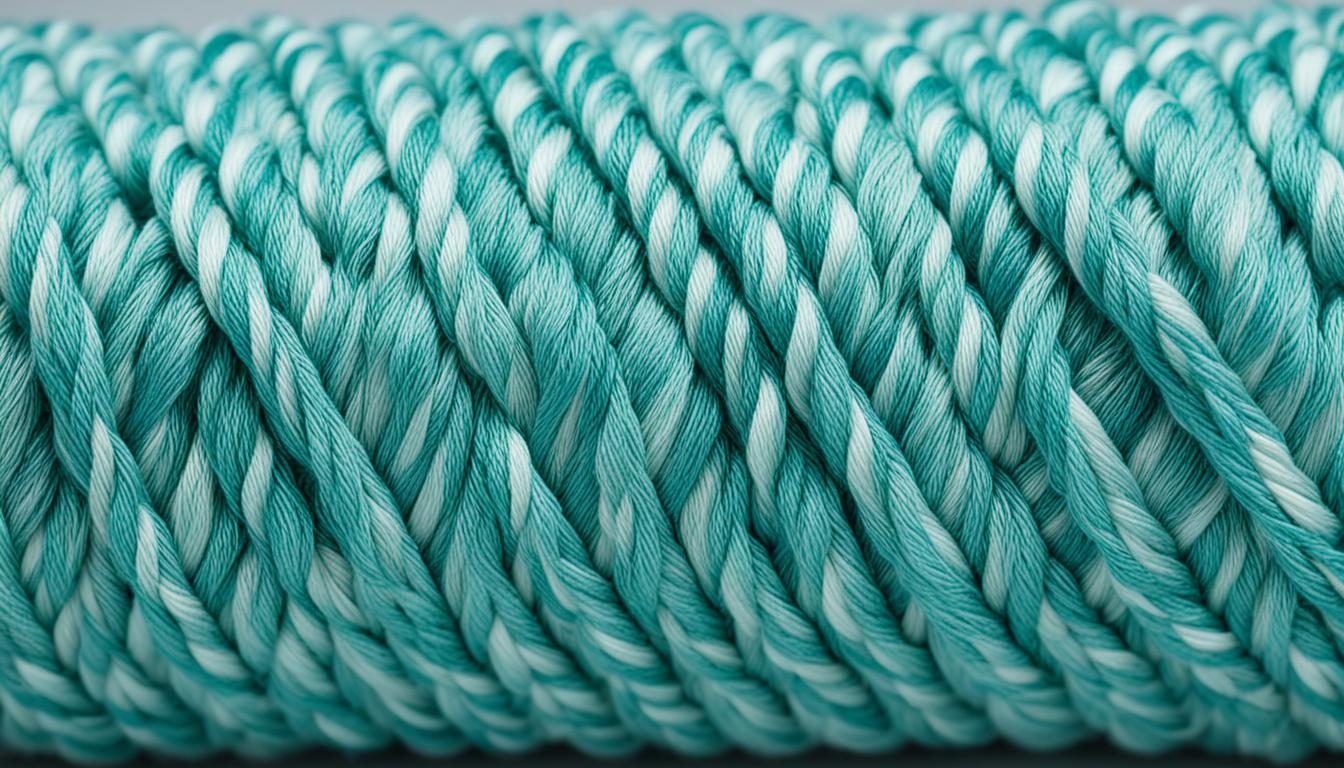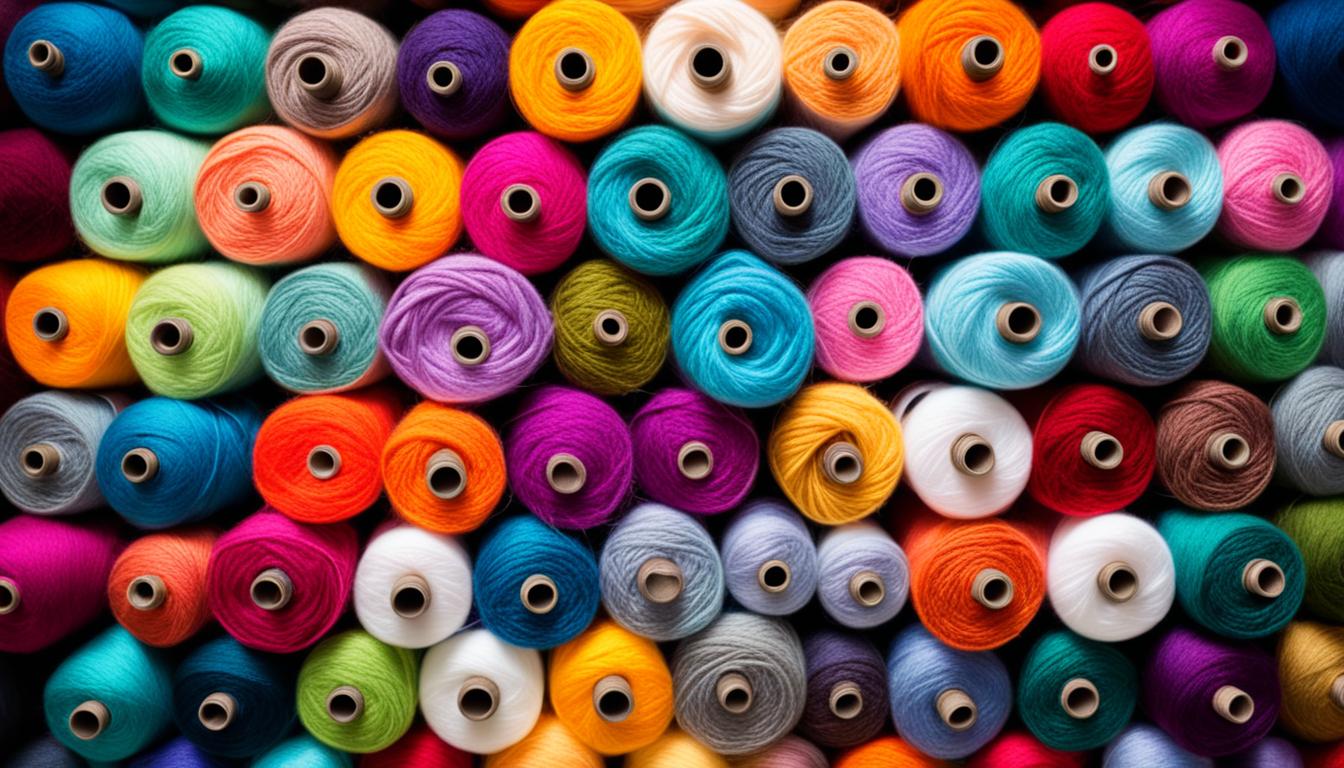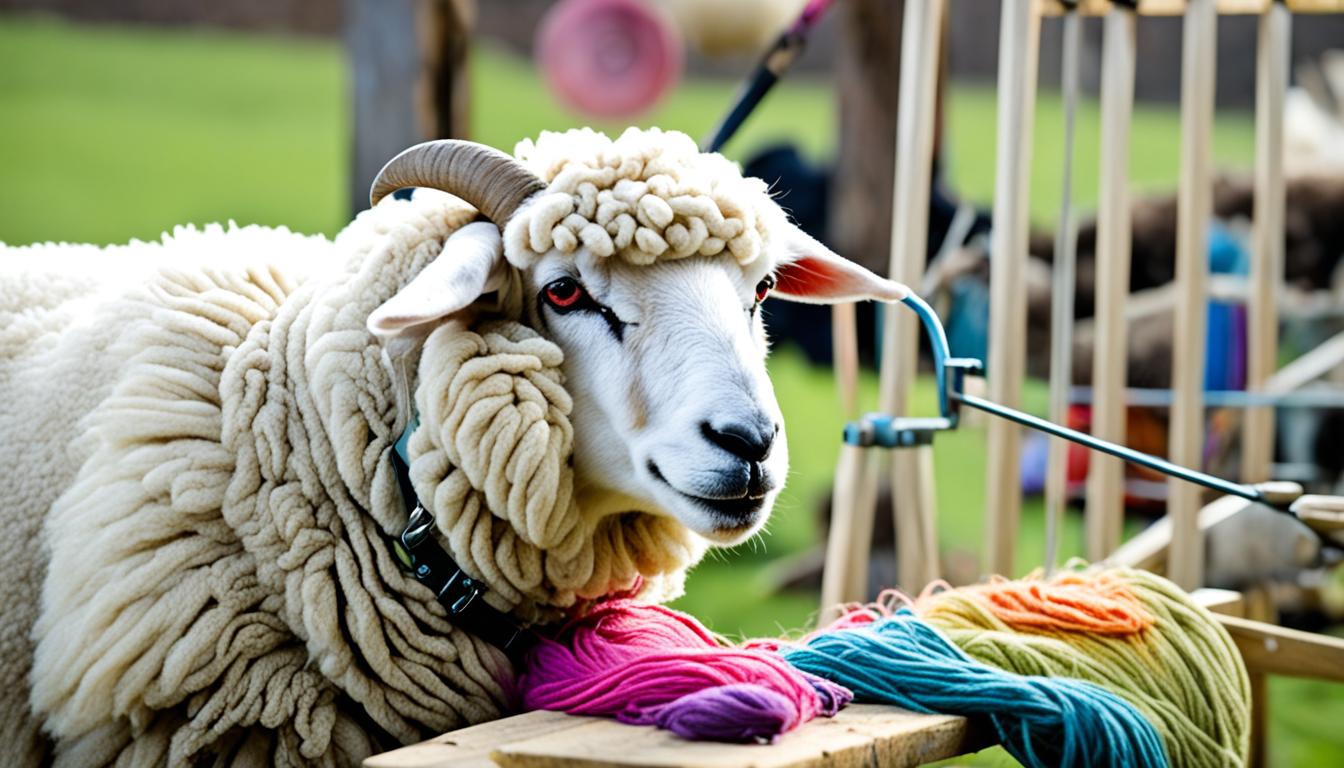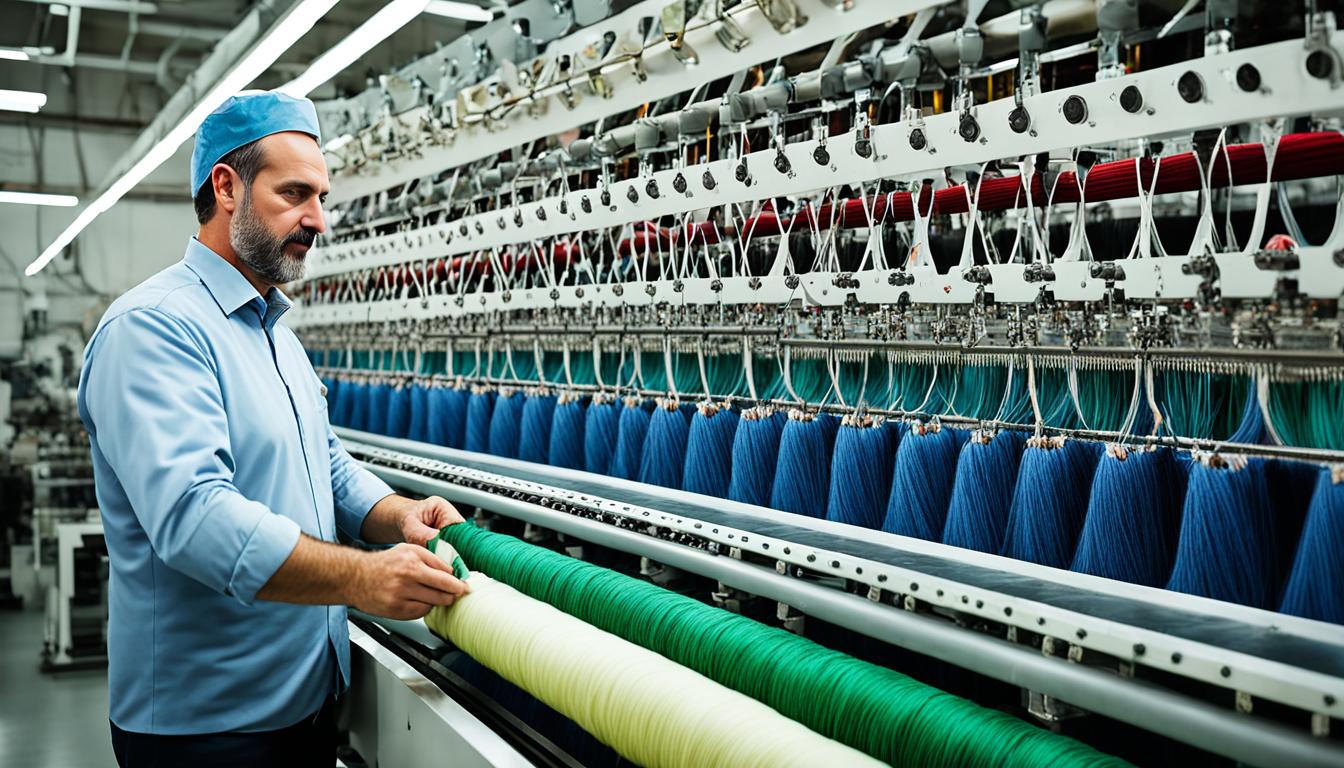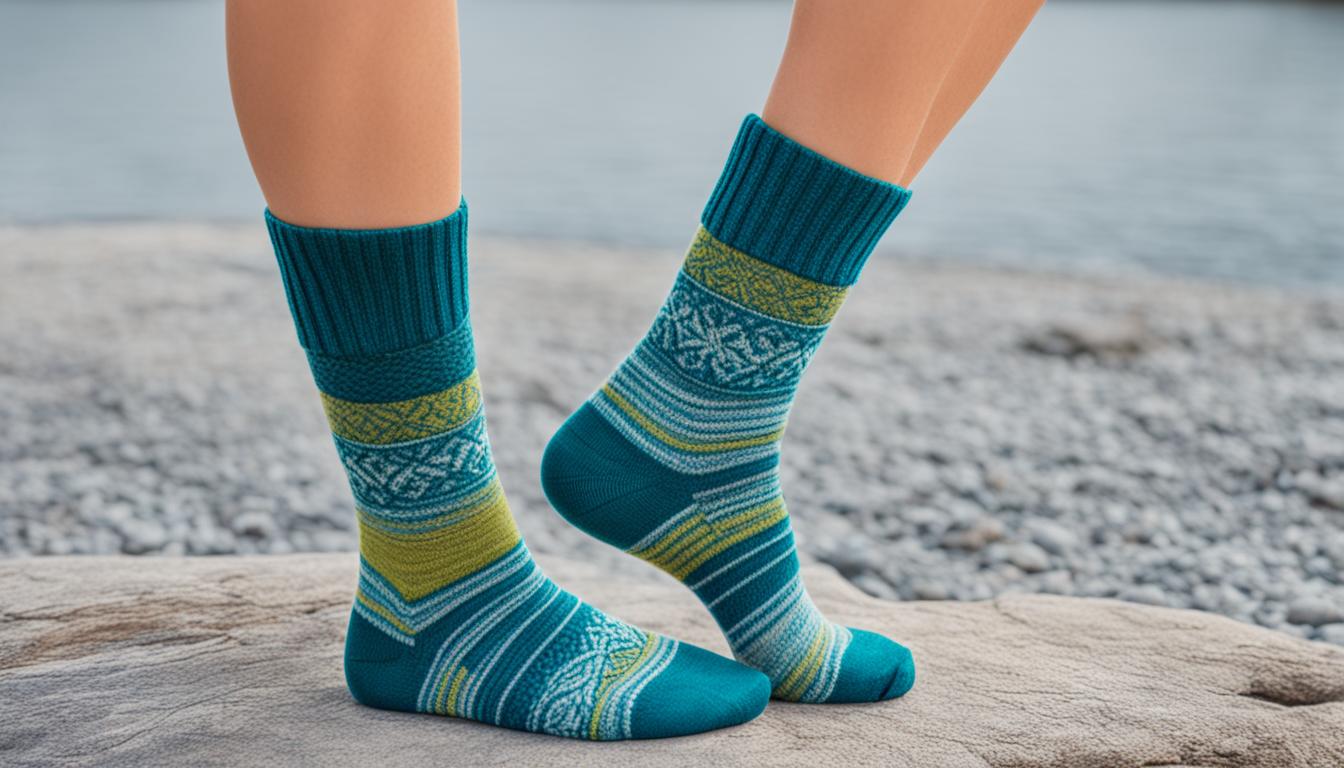When it comes to tufting, the size of the yarn you use is essential in achieving the desired results. But what is the ideal yarn size for a tufting gun? Does yarn weight truly make a difference in creating stunning tufted pieces? Let’s explore the realm of tufting and reveal the secrets to selecting the perfect yarn thickness for your tufting gun.
Key Takeaways:
- Choosing the right yarn size is important for achieving the desired texture and durability in tufted projects.
- Consider factors such as yarn weight, compatibility with the tufting gun, and intended use of the tufted product.
- Acrylic, cotton, and wool are the main types of yarn used for tufting guns, each with their own characteristics and suitability for different purposes.
- A 3 or 4 ply yarn is generally recommended, but personal preference and desired outcome also play a role in selecting the yarn size.
- Experiment with different yarn types and sizes to create unique and stunning tufted rugs and artwork.
Types of Yarn for Tufting Gun
When it comes to tufting gun projects, choosing the right yarn is crucial for achieving the best results. There are three main types of yarn commonly used for tufting guns: acrylic, cotton, and wool.
Acrylic Yarn
Acrylic yarn is a popular option for tufting non-floor pieces. It is affordable, soft, and easy to work with. However, it is important to note that acrylic yarn is flimsier compared to other types, so it may not be as suitable for heavy-duty use or floor rugs.
Cotton Yarn
Cotton yarn is a versatile and eco-friendly choice for tufting both wall pieces and rugs. It offers a moderate level of softness and is available in a wide range of colors and textures. Cotton yarn is known for its durability, making it ideal for projects that require more resilience.
Wool Yarn
For those seeking the most durable and traditional option, wool yarn is the way to go. Wool is known for its exceptional strength and resilience, making it perfect for tufting high-traffic areas like floor rugs. It provides a luxurious texture and is available in various thicknesses.
When selecting the best yarn for your tufting gun, consider the intended use and desired outcome of your project. Acrylic yarn is great for non-floor pieces, cotton yarn offers versatility, and wool yarn provides durability for floor rugs. Experiment with different yarn types to achieve the desired texture and look for your tufted creations.
| Type of Yarn | Characteristics | Recommended Use |
|---|---|---|
| Acrylic Yarn | Affordable, soft, and flimsy | Ideal for non-floor pieces |
| Cotton Yarn | Moderately soft, versatile, and eco-friendly | Suitable for wall pieces and rugs |
| Wool Yarn | Durable, traditional, and luxurious | Perfect for floor rugs |
Factors to Consider for Yarn Size
When selecting the right yarn size for your tufting gun, several factors come into play. The most crucial consideration is the size of the hole in your tufting gun. The yarn you choose should be thick enough to prevent slipping after each stroke, ensuring that your tufts remain secure. For this reason, it is recommended to use multiple strands or opt for a thicker yarn.
The thickness of the yarn also affects the density and consistency of your tuft. A 3 or 4 ply yarn is generally recommended for achieving the desired results. However, it ultimately depends on your personal preference and the specific outcome you want to achieve with your tufted project.
“The size of the yarn you choose is a crucial factor that influences the outcome of your tufted project. By selecting the appropriate yarn size, you can ensure the stability and durability of your tufts, resulting in a high-quality finished piece.”
Consider the tufting gun yarn size chart and tufting gun yarn guide to help you make an informed decision regarding the size of the yarn for your tufting gun. These resources provide valuable insights and recommendations based on the experiences of tufting enthusiasts.
In the next section, we will discuss recommended yarn sizes for tufting guns, providing you with practical guidance to help you get started on your tufted projects.
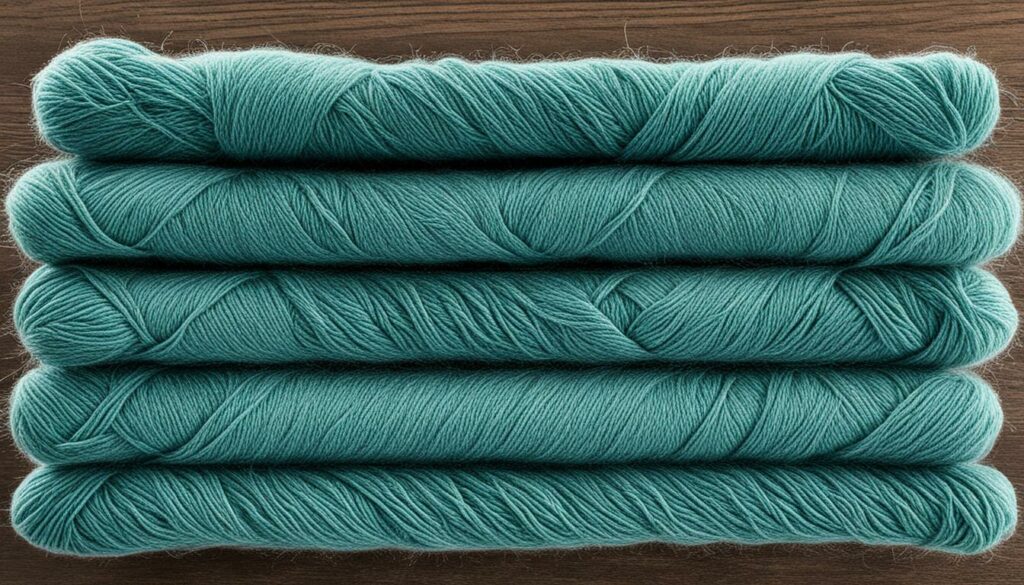
Recommended Yarn Sizes for Tufting Guns
When it comes to choosing the right yarn size for your tufting gun, it can be a bit overwhelming with so many options available. However, we are here to provide you with some recommendations to make the process easier.
A general rule of thumb – and this is not a hard and fast rule – is to use a 3 or 4 ply yarn for tufting. These yarn sizes are versatile and commonly used by tufting enthusiasts. The thickness of a 3 or 4 ply yarn provides a good balance between achieving a thick line in the backing cloth and ensuring a consistent and durable tuft.
Using two strands of yarn in your tufting gun can also help increase the bulk of your tuft and create a fuller look.
When choosing your yarn size, it’s important to consider the hole size of the needle on your tufting gun. You’ll want to ensure that the yarn fits easily through the needle to prevent any jamming or difficulties during the tufting process.
By following these recommendations and considering your personal preference, you can select the right yarn size that suits your tufting needs. Remember, experimenting with different yarn sizes can also lead to unique and stunning tufting creations that showcase your individual style and creativity.
Give it a try, and you’ll see how the right yarn size can make a big difference in the outcome of your tufted projects!
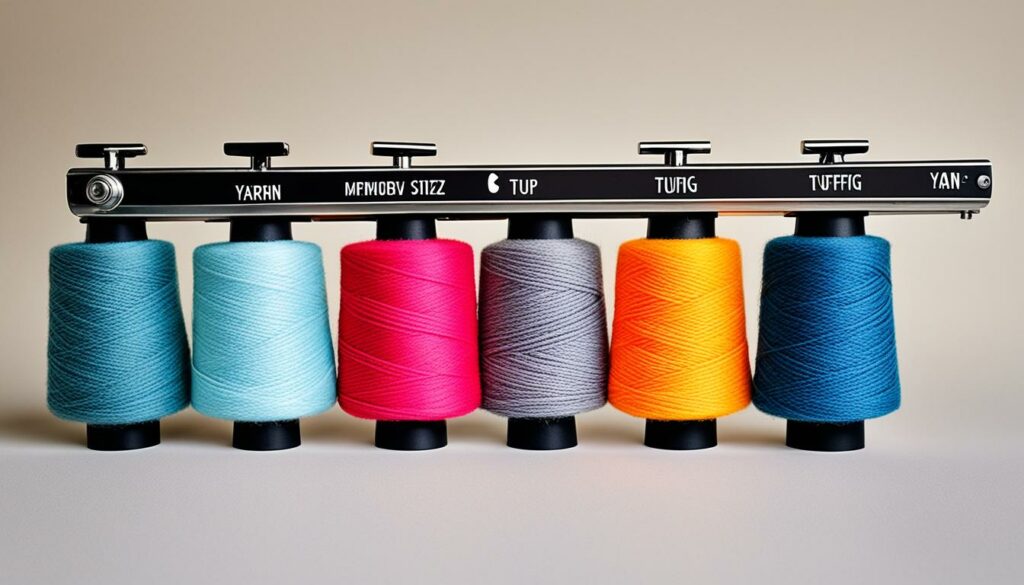
Recommended Yarn Sizes for Tufting Guns
| Yarn Size | Pros | Cons |
|---|---|---|
| 3 ply | Creates a balanced tuft with good texture and durability | May not achieve the thickest tuft possible |
| 4 ply | Provides a fuller look with increased bulk | May require tighter tension to prevent slipping |
| Two strands of yarn | Produces a denser tuft with enhanced visual impact | Requires more coordination and may increase tufting time |
Where to Buy Yarn for Tufting Guns
When it comes to finding the perfect yarn for your tufting gun, you have a variety of options to choose from. Whether you prefer to shop locally or online, there are numerous retailers that offer a wide selection of yarn specifically designed for tufting. By exploring different sources, you can find the yarn that best suits your project needs.
If you prefer the convenience of shopping in-person, local craft stores like Michaels, Walmart, and Joann’s are great places to start. These stores often carry a diverse range of yarn options suitable for tufting guns. You can find different colors, textures, and thicknesses to match your creative vision. Plus, you can take advantage of any ongoing sales or promotions to ensure you get the best value for your money.
For those who prefer the ease and accessibility of online shopping, there are several reputable websites that specialize in tufting gun yarn. Websites such as tuftinggun.com, knitpicks.com, and yarnspirations.com offer a wide selection of yarn specifically curated for tufting projects. These online platforms provide detailed descriptions and images of each yarn, making it easier to compare and choose the right option for your needs.
Exploring secondhand options can also be a budget-friendly way to acquire yarn for tufting guns. Platforms like Facebook Marketplace and eBay often have listings for gently used or unused yarn at discounted prices. While availability may vary, browsing these platforms can uncover hidden gems at a fraction of the retail cost.
Regardless of where you choose to buy your yarn, ensure that it meets your quality standards and fits your tufting gun’s specifications. Take into consideration factors such as the yarn weight, thickness, and fiber composition. By selecting the right yarn, you can elevate your tufting projects and bring your creative visions to life.
Comparison of Yarn Sources for Tufting Guns
| Retailer | Advantages | Disadvantages |
|---|---|---|
| Local Craft Stores (Michaels, Walmart, Joann’s) | – Wide selection of yarn options | – Limited stock availability |
| Online Stores (tuftinggun.com, knitpicks.com, yarnspirations.com) | – Convenient shopping experience | – Potential delays in shipping |
| Secondhand Options (Facebook Marketplace, eBay) | – Cost-effective alternative | – Limited availability and selection |
With the variety of sources available, you can easily find the perfect yarn for your tufting gun projects. Whether you prefer the hands-on experience of local craft stores or the convenience of online shopping, the right yarn is just a few clicks or a short trip away. So, get ready to unleash your creativity and embark on your next tufting adventure!
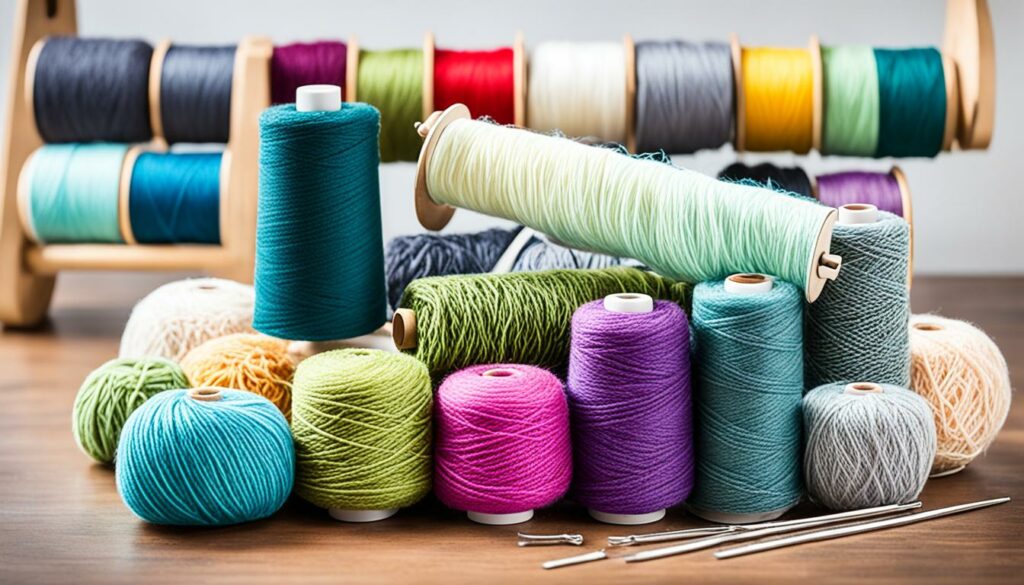
Additional Tips for Yarn Selection
When selecting yarn for your tufting gun, it’s important to consider the intended use of your tufted product. Different yarn options offer varying levels of durability and suitability for different applications.
For non-floor pieces or decorative items, you have the freedom to choose any type of yarn. This includes options such as cotton, wool, or even acrylic yarn. Consider the texture, color, and overall aesthetic you want to achieve with your tufted piece. Think about how the yarn will complement the design and add a unique touch to your artwork or decoration.
Tip: Experiment with different yarn types to create diverse textures and effects in your tufted projects. The versatility of tufting allows for endless creative possibilities!
However, when it comes to floor rugs that will experience more wear and tear, it’s best to prioritize durability. Acrylic yarn, while soft and affordable, may not withstand the demands of a high-traffic area. Instead, opt for eco-friendly cotton or resilient wool yarn options. These materials offer better resistance to foot traffic and are more likely to maintain their shape and appearance over time.
Remember that the quality of the yarn you choose will directly impact the quality of your tufted rug or artwork. Investing in high-quality yarn ensures a more satisfying and long-lasting finished product.
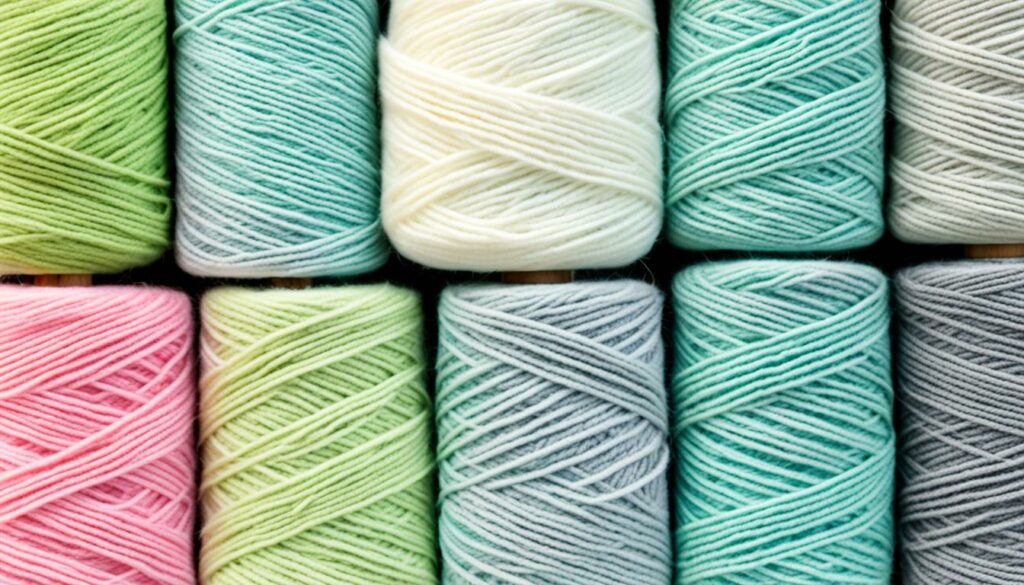
Comparing Yarn Options for Tufting Guns
| Yarn Type | Pros | Cons |
|---|---|---|
| Cotton | Environmentally sustainable, versatile texture, suitable for various tufting projects | May be less durable than wool |
| Wool | Durable, traditional choice for floor rugs, provides excellent insulation | Somewhat more expensive than other options |
| Acrylic | Soft, affordable, available in a wide range of colors | Less durable, may flatten or pill over time |
As you venture into the world of tufting, consider the specific requirements of your project and choose yarn that aligns with your desired outcome.
Creating a Tufting Gun Starter Kit
In addition to selecting the right yarn size for your tufting gun, there are other essential items you’ll need to get started with tufting. These items will ensure a smooth and seamless tufting experience, allowing you to create beautiful tufted rugs and artwork. Here are the essential items for your tufting gun starter kit:
Tufting Gun
The tufting gun is the primary tool used in tufting. It allows you to shoot the yarn into the fabric, creating tufts and designs. When choosing a tufting gun, opt for a reliable, high-quality option that suits your needs and preferences.
Frame
A frame is essential for holding the fabric taut while you work. It provides stability and tension, allowing for accurate tufting. When selecting a frame, consider its size and stability, ensuring it can accommodate the fabric and withstand the tufting process.
Primary Tufting Cloth
The primary tufting cloth is the backing fabric where you shoot the yarn into with your tufting gun. It is specially designed for tufting, with pre-cut holes for easy insertion of the yarn. Ensure the primary tufting cloth is tightly secured on the frame to prevent any loose or uneven tufts.
Rug Carving Tools
Rug carving tools are used to create depth and definition in your tufted designs. These tools allow you to shave along the lines of the design, enhancing its overall appearance. Use rug carving clippers for precise and level trimming.
Scissors
Scissors are essential for cutting out the tufted rug from the backing cloth and removing any loose or uneven tufts. Opt for a pair of scissors specifically designed for tufting, such as duckbill napping shears, to achieve clean and professional cuts.
Loop Threader
A loop threader is handy for threading the yarn through the tufting gun needle. It helps ensure smooth and efficient tufting by preventing yarn tangling or breakage. Invest in a high-quality loop threader for ease of use and durability.
Carpet Glue
To secure the tufts and prevent them from coming loose, carpet glue is necessary. Choose a carpet glue that provides flexibility and durability. Latex-based adhesives are commonly used for tufting rugs. Follow the provided safety instructions and allow the glue to dry in a well-ventilated area.
By assembling these essential items into a tufting gun starter kit, you’ll have everything you need to embark on your tufting journey. Whether you’re a beginner or an experienced tufter, having the right tools and materials is key to achieving impressive and professional results.
| Essential Items | Description |
|---|---|
| Tufting Gun | The primary tool used for tufting, allowing you to shoot yarn into the fabric. |
| Frame | Holds the fabric taut, providing stability and tension during the tufting process. |
| Primary Tufting Cloth | The backing fabric where you shoot the yarn into, with pre-cut holes for easy tufting. |
| Rug Carving Tools | Used to create depth and definition in tufted designs, providing a finished look. |
| Scissors | Designed specifically for tufting, used for cutting out the tufted rug and trimming tufts. |
| Loop Threader | Helps thread the yarn through the tufting gun needle, preventing tangling or breakage. |
| Carpet Glue | Secures tufts in place, preventing them from coming loose during use. |
With these essential items and your chosen yarn size, you’re well-equipped to begin your tufting journey. Let your creativity flow and explore the endless possibilities of tufting, creating unique and stunning tufted rugs and artwork.
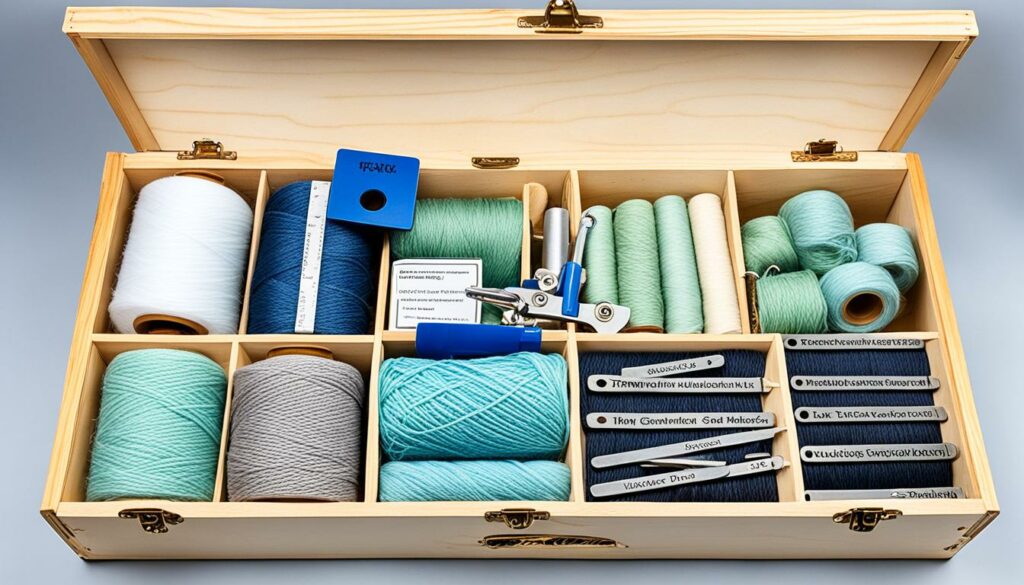
Building a Frame for Tufting
When it comes to tufting, having a sturdy frame is essential to ensure that the fabric remains taut while you work. Building your own DIY frame not only allows for customization but also helps you save money. Here’s what you need to know about constructing a frame for your tufting project:
- Sturdiness: Make sure your frame is strong and stable to prevent any wobbling or tipping during the tufting process. This will ensure that your stitches are even and precise.
- Size: Consider the size of your frame based on the dimensions of your tufted project. A recommended maximum frame size is around 190cm by 190cm, which comfortably accommodates a standard 200x200cm rug backing. Adjust the dimensions according to your needs.
- Yarn Feeding System: To streamline the tufting process and avoid tangling or snagging, incorporate a yarn feeding system into your frame design. This will help you effortlessly guide the yarn through the tufting gun.
- Frame Grippers: To keep the fabric securely in place, consider adding frame grippers to the edges of your frame. These grippers will hold the fabric tightly and prevent it from slipping or sagging.
By building your own frame, you have the flexibility to customize it to your specific needs. Whether you’re working on a small art project or a large rug, a well-constructed frame will provide the stability and support necessary for successful tufting.
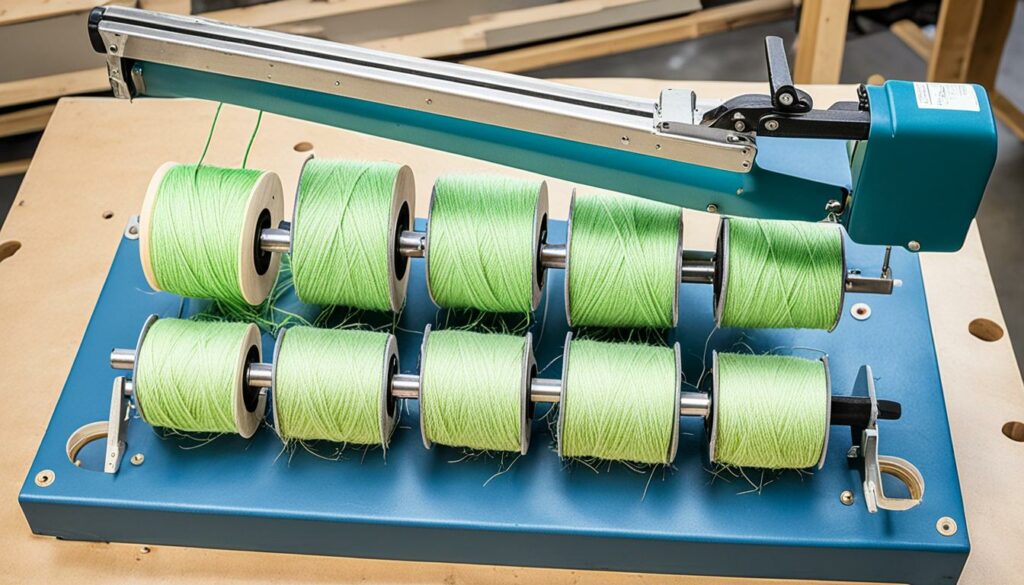
Why a Sturdy Frame Matters
A sturdy frame is crucial for tufting projects because it provides stability, ensuring that the fabric remains taut and doesn’t move or shift during the tufting process. This stability allows for more accurate and precise stitches, resulting in a well-crafted tufted piece.
Remember to take your time when constructing the frame, using materials that are durable and reliable. This will ensure a smooth and enjoyable tufting experience, ultimately leading to beautiful and professional-looking tufted creations.
Selecting Primary Tufting Cloth
When it comes to tufting, the primary tufting cloth is a crucial element that determines the overall quality and durability of your tufted projects. This backing fabric serves as the foundation where you shoot the yarn into with your tufting gun. To ensure optimal results, it is essential to select a specific type of rug backing fabric that is designed to withstand the high speeds and aggressive nature of tufting machines.
We recommend using tufting-specific cloths, which are specifically engineered for this purpose. These cloths are made from high-quality materials that provide the necessary strength and flexibility to withstand the tufting process. They also come with pre-cut holes that allow for easy and precise tufting, saving you time and effort.
When selecting the primary tufting cloth, it is important to ensure that it is tightly secured on the frame. This helps prevent any loose or uneven tufts and ensures a consistent and professional finish. Additionally, a tight and taut cloth provides better control and accuracy during the tufting process.
Overall, choosing the right primary tufting cloth is an essential step in achieving the best results with your tufting gun. By using a tufting-specific cloth, you can ensure durability, ease of use, and a high-quality finish for your tufted rugs and artwork.
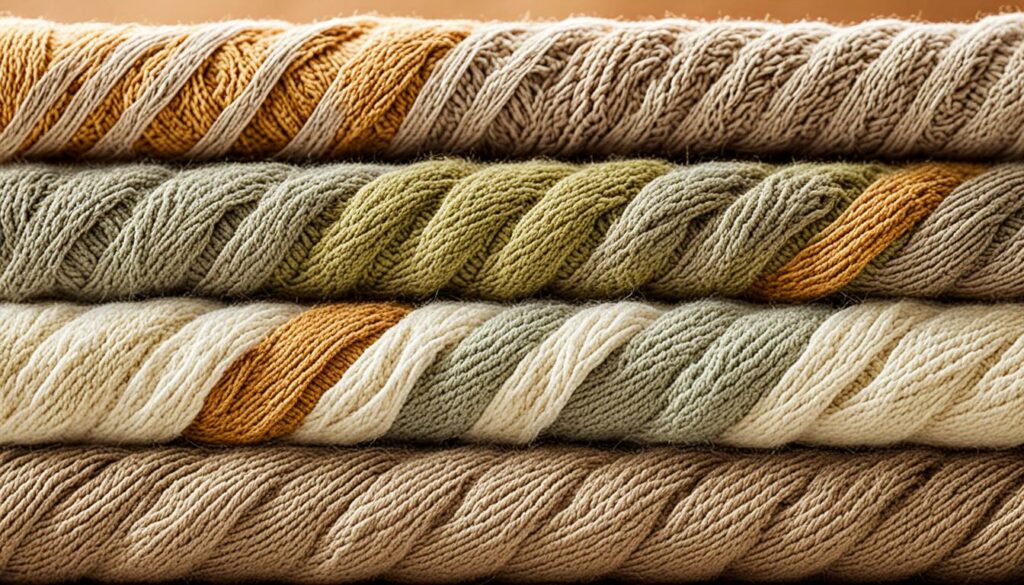
Comparison of Primary Tufting Cloth Options
| Tufting Cloth Type | Material | Features |
|---|---|---|
| Tufting-Specific Cloth | High-quality fabric designed for tufting | – Stretchy and resilient material – Pre-cut holes for easy tufting – Provides a secure foundation for tufted yarn – Ensures a professional finish |
| Traditional Rug Backing | Standard rug backing materials | – May require manual hole punching – Less stretchy and durable compared to tufting-specific cloths – Not specifically designed for tufting, but can be used with modifications |
| Alternative Fabrics | Various materials such as canvas or upholstery fabric | – May require manual hole punching – Limited stretch and potential difficulty in achieving a tight fit on the frame – Can be used as an alternative, but may not provide optimal results |
Rug Carving and Finishing
After completing the tufting process for your rug, there are a few additional steps you can take to achieve a polished and professional look. Rug carving and finishing techniques help enhance the design by adding depth, definition, and a smooth surface. Let’s explore these steps in detail:
Rug Carving
Rug carving involves carefully shaving along the lines of your design to create depth and definition, especially for lettering or intricate patterns. This technique brings out the details and makes the design stand out. To achieve accurate and level trimming, it is recommended to use rug carving clippers specially designed for this purpose.
By using rug carving clippers, you have better control over the carving process, allowing you to create precise cuts while maintaining the integrity of the design. Take your time and work slowly to ensure the best results. Remember, rug carving is a delicate process that requires patience and attention to detail.
Rug Finishing
Once you have finished rug carving, the next step is to give your rug a final shave. This process helps smoothen and level the surface, ensuring an even and polished appearance. To perform the final shave, you will need a pair of scissors specifically designed for this purpose, such as duckbill napping shears.
With the duckbill napping shears, carefully trim the rug surface, removing any loose or uneven tufts. Pay close attention to the edges and corners, ensuring a clean and well-finished look. Take your time during this step to achieve the desired result.
Once you are satisfied with the rug carving and finishing, you can proceed to cut out the rug from the backing cloth. Use the scissors to carefully cut along the edges, following the design’s outline. Be cautious to avoid cutting through any tufts or damaging the rug’s structure.
By following these rug carving and finishing techniques, you can elevate the visual appeal and quality of your tufted rug. These steps add the final touches that make your creation truly exceptional.
Check out the example image below to see the incredible transformation that rug carving and finishing can bring to a tufted rug:
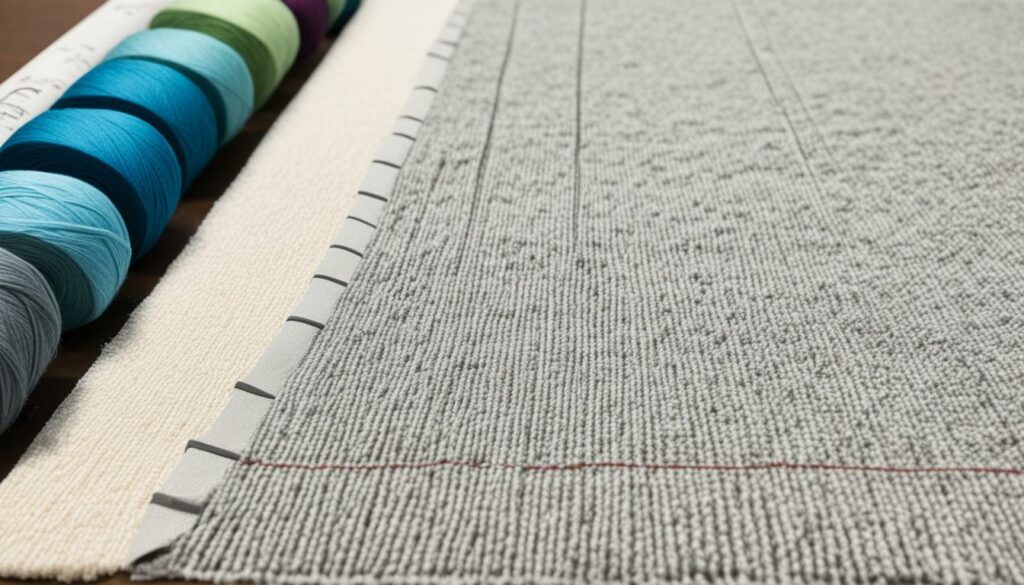
| Rug Before Carving and Finishing | Rug After Carving and Finishing |
|---|---|
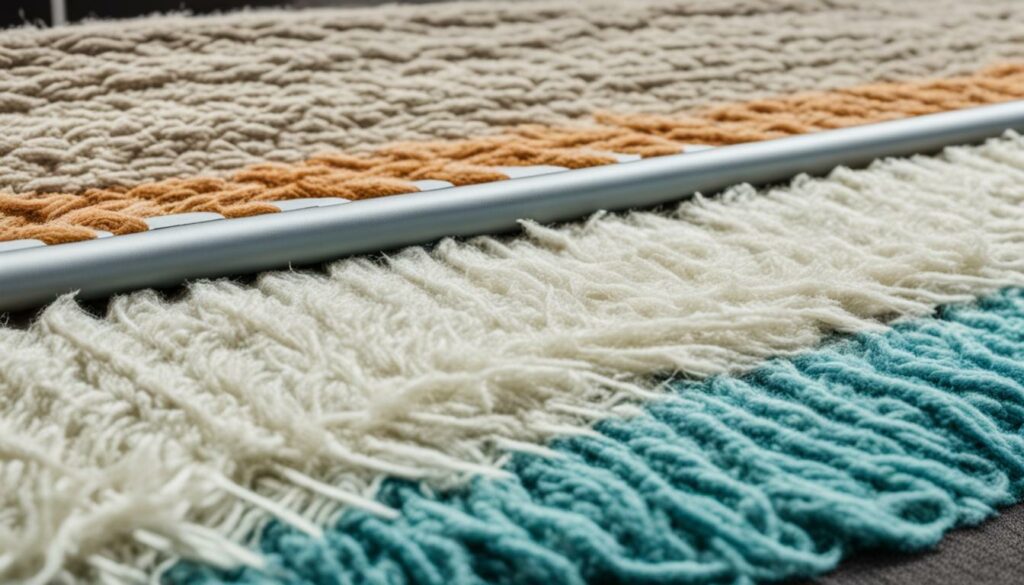 |
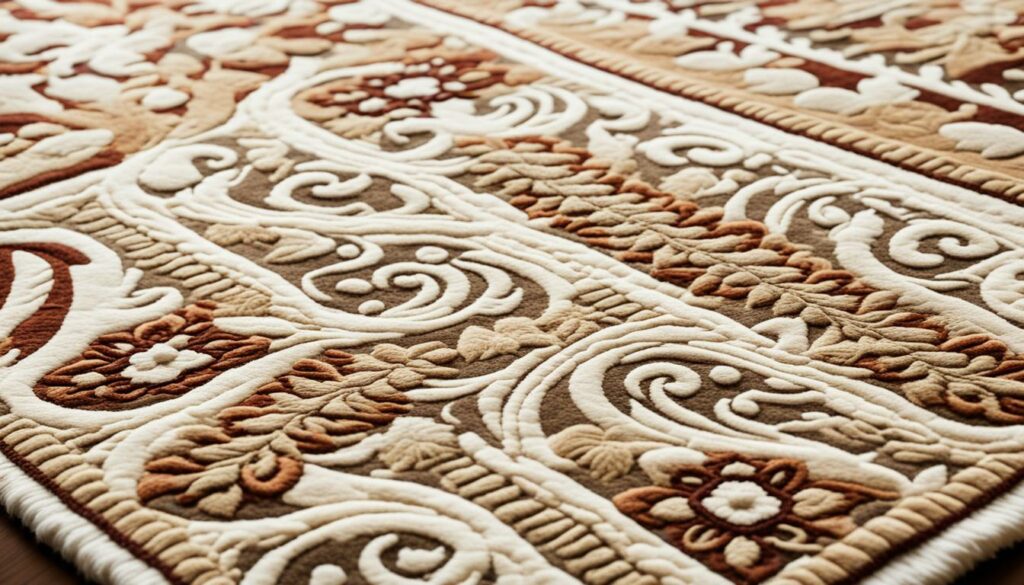 |
As you can see, the rug carving and finishing process adds dimension and refinement to the design, taking it from a simple tufted rug to a stunning piece of art.
In the next section, we will explore the final steps of gluing and finishing the rug to ensure long-lasting durability.
Gluing and Finishing the Rug
To ensure the longevity and durability of your tufted rug, it is crucial to properly glue and finish the back of the rug. This step helps secure the tufts in place, preventing them from coming loose over time. It also adds stability and provides a smooth and polished finish to your rug.
For the gluing process, various types of carpet glue or adhesive can be used. One popular option is latex-based carpet glue, which offers flexibility and durability. Other adhesive products specifically designed for rug finishing and tufting are also available in the market.
Remember: Before applying any glue or adhesive, ensure that the rug is still attached to the backing cloth. Gluing should be done before cutting out the rug from the cloth to ensure that all tufts are firmly secured.
When gluing the rug, it is essential to follow the manufacturer’s instructions and use the recommended amount of glue. Apply a thin and even layer of glue all over the back of the rug, ensuring that it covers the entire area. Pay extra attention to the edges and corners to ensure a strong bond.
Once you have applied the glue, allow it to dry in a well-ventilated area, following the recommended drying time provided by the adhesive manufacturer. This step is crucial for the adhesive to fully cure and create a strong bond between the tufts and the backing cloth.
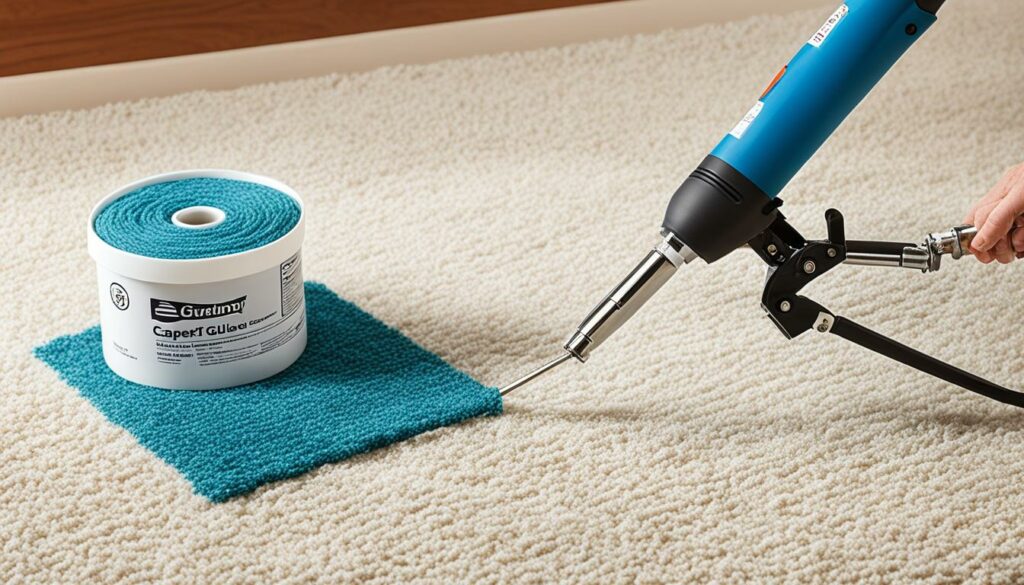
Once the glue has fully dried, you can proceed with trimming any excess backing cloth around the edges of the rug. Use a sharp pair of scissors to carefully cut along the outline of the rug, ensuring a clean and neat finish.
Finally, inspect the rug for any loose or uneven tufts. Use scissors or a trimmer to gently remove any tufts that appear out of place, creating a smooth and uniform surface.
Conclusion
When it comes to tufting, selecting the right yarn size for your tufting gun is crucial for achieving the desired texture and durability of your projects. Consider factors such as the weight of the yarn, its compatibility with the tufting gun, and the intended use of your tufted product. By carefully choosing the yarn size, you can create stunning tufted rugs and artwork that will stand the test of time.
In addition to yarn size, building a comprehensive tufting gun starter kit is essential for a smooth tufting experience. Include essential items such as the tufting gun, frame, tufting cloth, and other tools necessary for your project. A well-equipped starter kit will ensure that you have everything you need to get started and create beautiful tufted pieces.
Don’t be afraid to experiment with different yarn types and sizes to unleash your creativity and achieve unique results. Whether you’re a beginner or an experienced tufter, the key is to enjoy the process and let your imagination run wild. With the right yarn size and a well-prepared tufting gun starter kit, the possibilities are endless.
